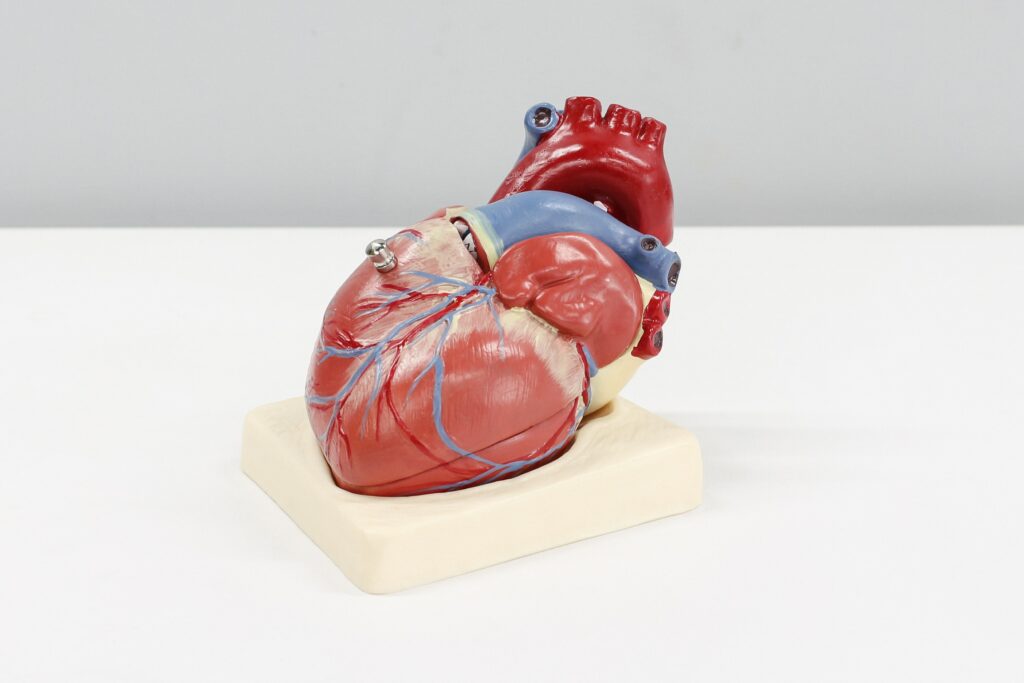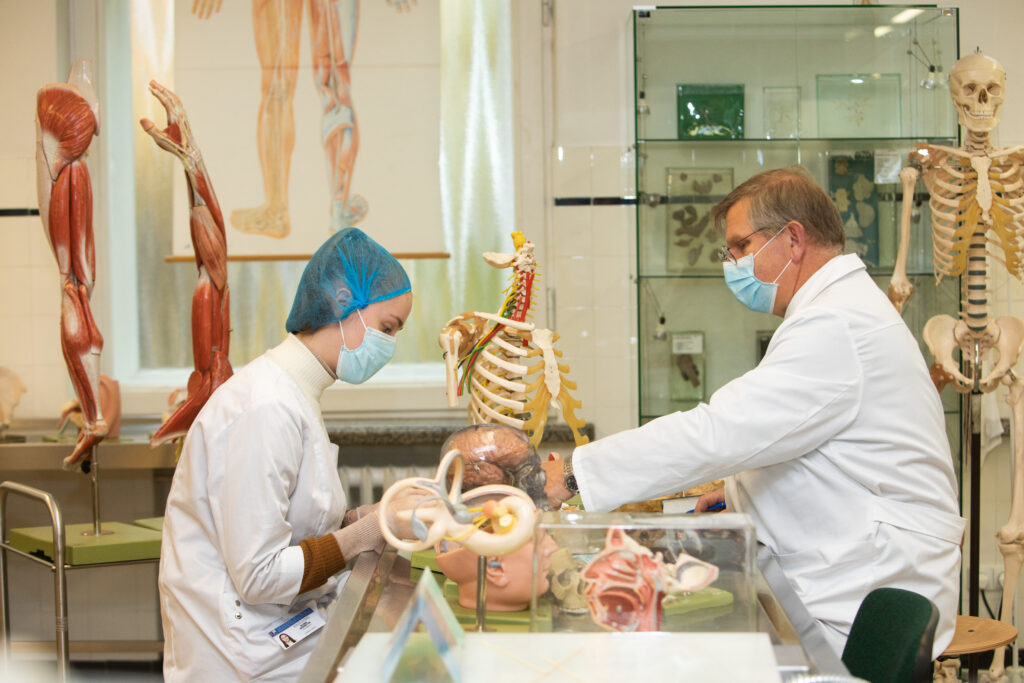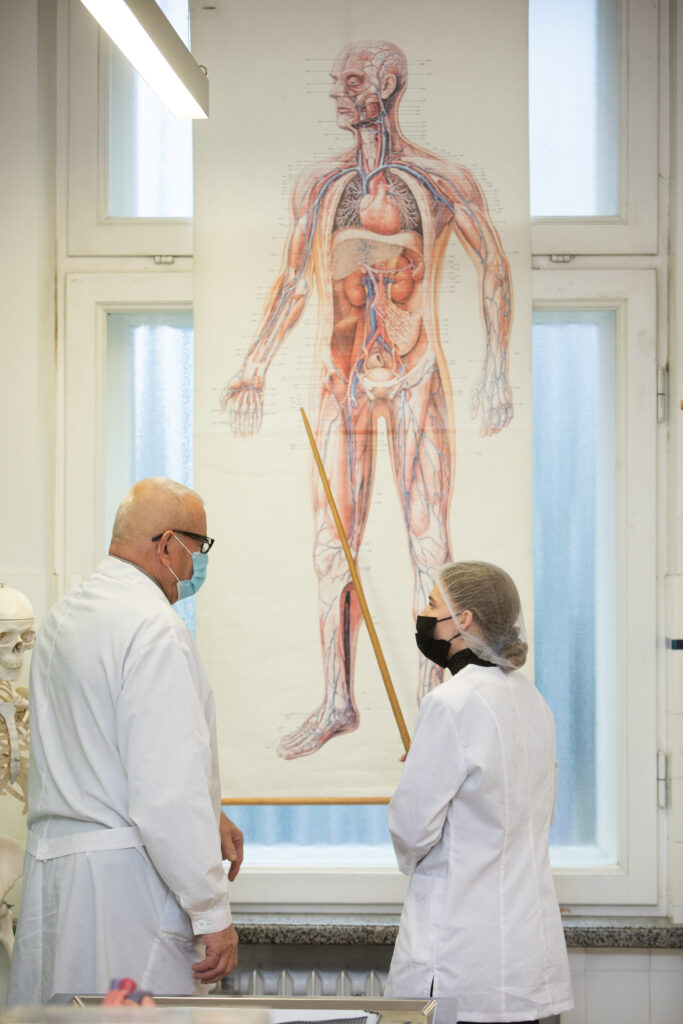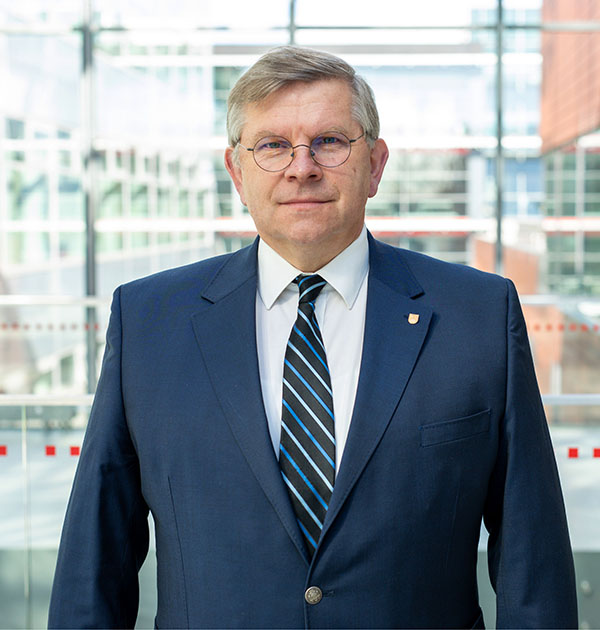
Institute of Anatomy
The aim of the Institute of Anatomy is to provide anatomical knowledge of the human body, organ systems and the structure of individual organs, as well as the knowledge necessary for the professional training of medical doctors and for the study of other fundamental courses in human biology. The structure of the Institute includes the Institute of Anatomy itself, the Museum of Anatomy, the Anatomy Laboratory, the Electron Microscopy Laboratory, and the Neuromorphology Laboratory.
Studies
The Institute of Anatomy teaches the Discipline of Human Anatomy to the first-year students of all study programmes of the Faculties of Medicine, Odontology, Pharmacy, Nursing, and Public Health (in Lithuanian and English). First-year students of the Faculty of Medicine prepare their final research theses (in Lithuanian and English).
Classes and practical sessions (in Lithuanian and English) are held for the second-year students of the Faculty of Medicine under the modules “Locomotion”, “Circulation”, “Respiration”, “Nutrient Uptake and Metabolism”, “Homeostasis and Excretion”; third-year students under the modules “Reproduction and Inheritance, “Immune Response”, “Sensation and Perception”, “Neuroendocrine Regulation”, and fifth-year students under the module “Intensive and Emergency Medicine”. The lecturers of the Institute of Anatomy are in charge of the modules “Locomotion” and “Neuroendocrine Regulation”.
The doctoral students at the University attend the courses of Neuroanatomy and Evolution of the Human Body delivered at the Institute, while resident doctors enhance their knowledge during the lectures and workshops on Functional Anatomy of the Masticatory System.
Research
There are two distinct periods in the development of the research activities at Institute of Anatomy: anthropology and neuroanatomy.The research activities in anthropology were conducted until 1940. Prof. J. Žilinskas and his students (A. Jurgutis, J. Dobrovolskaite-Tikniene, R. Masalskis, and others) studied fossil human skulls and somatometric parameters of Lithuanian and East Prussian populations. In the post-war years, the research in anthropology was further developed by Prof. S. Pavilonis, a student of Prof. J. Žilinskas, at Vilnius University, and by Prof. J. Nainys in Kaunas.
The field of neuroanatomical research began to take shape in the post-war years when Assoc. Prof. A. Jurgutis summarised the data on individual, age-related and sexual variations in the weight of the human brain and the dimensions of the brainstem from his collection of human brains collected before the war. The results of his research were summarised in his thesis “Variations in the weight and dimensions of the human brain”, which he defended at the Council of Morphological Sciences of the USSR Academy of Medical Sciences in 1957. This was the first independent work carried out by Lithuanian neuroanatomists, and Lithuanian morphologists in general, and successfully defended in Moscow.
In the 1960s, the Department saw an increase in the number of works in the field of cardiovascular neuromorphological research, which was initiated by A. Urbonas, who had mastered the methods of vascular innervation research. As the number of students was increasing during this period, the Department staff was joined by young lecturers who quickly mastered these methods and successfully became involved in the emerging cardiovascular neuroanatomical research, which continues to this day. Throughout this period, neuroanatomical research techniques have been continuously updated and improved. Starting with mesoscopic preparation and neurohistological impregnation techniques, the researchers at the Department have developed more specific neurohistochemical, electron microscopy, biophysical and immunohistochemical techniques. The results of cardiovascular neuroanatomical studies have been summarised in the theses of 22 Doctors of Science and 2 Habilitated Doctors of Science.

The first phase of this field of research focused on the innervation of arterial blood vessels in healthy people and their alterations in case of certain diseases. In the 1970s, the researchers at the Department embarked on the study of the histophysiological features of the neural regulation of the heart, and new histochemical methods were mastered, which enabled a shift from descriptive work to histophysiological studies of neural structures. Aspects of the comparative morphology of the intracardiac nervous apparatus of the heart, age-related changes and alterations of the nervous structures in the presence of coronary circulation pathology were identified.
Cardiac innervation has been a long-standing research area at the Institute of Anatomy. In recent years, modern research methods have been introduced. Currently, the topography of intracardiac nerve plex, the structural organisation of the nerve ganglia, the ultrastructure and histochemistry of intracardiac neurons and nerve fibres are studied by histochemical, immunohistochemical, electron microscopy, and neuroanatomical (methylene blue supravital staining, intracellular labelling) methods.
In 1989, the Neuromorphology Research Group was established within the Department of Human Anatomy. Biologists holding university degrees joined the Group and successfully developed the research activities at the Department, building its greater methodological and scientific fundamentalism. This enabled the results of the research to be published in highly regarded international journals.
The results of neuroanatomic research at the Institute of Anatomy have been summarised in 20 dissertations. These works have been presented and gained favourable acceptance at scientific conferences, congresses and symposia of neuromorphologists, physiologists, and cardiologists. The Institute is one of the few fundamental research departments that has been conducting neuroanatomical research for 40 years and has created a distinctive school of neuroanatomists. Its technical facilities and methodological level have enabled the training of researchers in Lithuania after the restoration of Independence.
The Institute also organises conferences for morphologists that have welcomed guests from Denmark, Sweden and other countries. The Institute maintains contacts with colleagues in Russia.
Foundation of the Institute
The years 1918-1919 in Lithuania were highly ambiguous. In 1919, the occupation of Vilnius deprived Lithuania of its only higher education institution – Vilnius University. On 13 July 1919, a group of medical doctors published a statement in the press about the necessity to create conditions for students who had returned to Lithuania from various European cities to complete their medical studies. Elected student representatives wrote a memorandum to this effect, which was submitted to the Health Department of the Ministry of the Interior and to Kaunas Medical Society. Before the government had time to react, the Medical Society, together with the students, drafted a programme for the Higher Medical Course, drew up an estimate and submitted it to the Government. Without waiting for a formal response from the Government, the Medical Society decided to set up a medical course on its own, which would be open to fourth (IV) and fifth (V) year students. This took place on 6 October 1919, and just a few months later, on 27 January 1920, the Higher Course for students of other specialities was launched at an official ceremony and became Kaunas University on 16 February 1922. Symbolically, the first step in higher education was a lecture on anatomy given by Jurgis Žilinskas, a surgeon at the Military Hospital, on 20 January 1920. He became the founder of the Institute of Anatomy. A building on Mickevičius Street was allocated to the Institute of Anatomy. A year later, another building was constructed in the courtyard and named “Anatomikumus”. Both buildings housed a dissection hall, a classroom, a Museum of Anatomy, a morgue, a laboratory, a library, a chemical storehouse, and other departments necessary for the anatomy department.

The first staff of the Institute consisted of Jurgis Žilinskas, acting professor; Liuda Tumaitė-Jaraškienė and Juzė Bubėnaitė, senior assistants; Julius Bučas, J. Statkevičius, Aleksandras Savickas, Voldemaras Grolis, junior assistants; Juozas Jaržemskas, laboratory assistant, and Stasys Daugėla, mortuary assistant. Later (1927-1932), the Institute was joined by senior assistant Antanas Aleknavičius, junior assistants Juozas Ambrazas, Jonas Čeponis, Juozas Jaržemskas, Kostas Nakvedavičius, Bronius Stukas, senior laboratory technician Vytautas Avižonis, mortuary assistant Jonas Radvinauskas, and demonstrator Ida Kronikaitė. In 1936, J. Dobrovolskaitė-Tiknienė, Romualdas Masalskis, and in 1940, Artūras Jurgutis joined the Institute. Before the war, A. Paprockas, V. Tamasionis, L. Damijonaitis, S. Pavilonis and O. Slavinskaitė-Sruogienė worked at the Institute on an occasional basis. There was a high turnover of staff, as the prevailing opinion was that those who wanted to become surgeons should have preferably worked as anatomists for a certain period of time. In fact, former collaborators of the Institute of Anatomy J. Jaržemskas, A. Aleknavičius, A. Paprockas, V. Tamasionis, L. Damijonaitis, and, after the war, Jonas Platūkis, Jonas Šošas, Leonas Kondrotas, Gintas Sabalys, etc., all subsequently became prominent surgeons.
During and After the War
At Kaunas University, anatomy was taught to students of the Faculties of Medicine and Natural Sciences and Mathematics. In addition, gynaecological and topographical anatomy practice classes were held in the dissection hall (prosectorium). The only source of knowledge was anatomy lectures. For this reason, Prof. Žilinskas made great efforts to publish Lithuanian course books. Since it was difficult to write and publish a course book covering the whole of anatomy in a short period of time, individual anatomy chapters were published. In 1924, “Lectures on Neurology”, in 1931 – “Osteology and Syndesmology” and in 1934 – “Splanchnology” were published. In addition to serving as the indispensable teaching aids, these course books were destined to become the origin of Lithuanian medical terminology. Other equally important activities of the Institute were the organisation of demonstration material and the creation of the Museum of Anatomy. Prof. J. Žilinskas, who had studied at the University of Dorpat, visited St. Petersburg and trained in Munich, had seen the best anatomy museums of the time, and realised that anatomy studies were worthless without anatomical preparations. Therefore, the Institute directed all its efforts towards the creation of the Museum of Anatomy. Just in the first days after establishment of the Institute, V. Starostinas (later associate professor of the Department of Anatomy at the Veterinary Academy of Lithuania) made and bound 20 skeletons, which became the first exhibits of the museum. Inspired by the example of Prof. J. Žilinskas, both his colleagues and students started producing the museum exhibits, with the most valuable contribution made by I. Kronikaitė and J. Radvinauskas.
The conditions for the development of the Institute of Anatomy were difficult at the beginning The small and inappropriate premises were cramped with large and complex facilities. The construction of a new building for the Faculty of Medicine, which began in 1931, offered hope. One of the buildings of the Institute of Anatomy demolished due to the construction of the main building further exacerbated the situation. Prof. J.Žilinskas was a member of the steering committee for the construction of the main building and secured for the entire west wing of the Medical Main Building for the Institute. In 1933, the new main building of the Faculty of Medicine was inaugurated, and the Institute of Anatomy was provided with premises adapted to its needs, including a spacious prosectorium, a morgue, a skeleton preparation laboratory, and a Museum of Anatomy with the appropriate exhibition furniture and other equipment necessary for anatomical studies.
The Institute of Anatomy built through hard work and dedication did not take long to build up for its team. The events of 1940 brought the first phase of the Institute to an end. Prof. Žilinskas left for Vilnius, which had been returned to Lithuania, where he became the head of the Anatomy Department of Vilnius University. In 1944, he moved to the West, where he passed away in 1957 (15 March 1957, Waterbury, Connecticut).
After Prof. Žilinskas left for Vilnius, R. Masalskis headed the Institute in 1940-1944, and A. Jurgutis, J. Dobrovolskaitė-Tiknienė, L. Petrauskas and J. Kaveckas worked as assistants. There was an atmosphere of uncertainty at the Faculty of Medicine at that time. The Faculty building was unheated and unlit. Practical classes were held in the prosectorium by candlelight and torches. Everyone had the sense of threatening arrest and deportation to Germany. Finally, on 19 March 1943, an order to close the Faculty of Medicine was issued and the students were met by German soldiers as they gathered for lectures. Although permission was later granted for the senior students to continue their studies, the classes of the first two years remained closed. J. Dobrovolskaitė-Tiknienė took the initiative and, in addition to the technical courses organised by Prof. K. Baršauskas and Prof. J. Purėnas, she established a medical technician unit, where she taught a course on anatomy based on the curriculum of the Faculty of Medicine to students.
The machine of war and occupation ruthlessly destroyed the assets of the Institute of Anatomy despite the selfless efforts of the collaborators of the Institute to protect it to the best of their ability. Nonetheless, they managed to preserve a part of the property by keeping them at their friends’ or own homes.

In 1944, Kaunas University reopened and included the medical, dental and pharmacy departments of the Faculty of Medicine. There were only two collaborators who have remained at the Institute of Anatomy from the pre-war period: A. Jurgutis and J. Dobrovolskaitė-Tiknienė They were the ones to deliver the first anatomy classes. A year later, as the number of students enrolled in the first year increased, the Department was initially joined by J. V. Nainys, followed by H. Gintautas, E. Gintautienė, L. Steponavičius, V. Steponavičienė, V. Sakalauskaitė-Rechlevičienė, V. Krisiukėnaitė, B. Jakubauskaitė, E. Miliūnaitė-Strockienė, A. Urbonas, R. Skačkauskaitė-Mikėnienė, and later on, the current collaborators. As usual, in addition to those already mentioned, H. Gintautas (radiologist), E. Gintautienė (obstetrician-gynaecologist), J. V. Nainys (forensic surgeon), P. Berūkštis (otorhinolaryngologist), V. Ksivickas (infectious disease specialist), R. Gailys (anatomical pathologist), G. Sabalys (surgeon-dentist) left the Institute of Anatomy to practice medicine. A great deal of credit is due to Jonas Želvis, a long-standing laboratory technician at the Institute of Anatomy, who carried the heavy burden of caring for the facilities of the Institute, which he handled with excellence.
From 1944 to 1967, until the last day of his life, the Department was headed by Associate Professor A. Jurgutis (except for 1950–1957, when it was merged with the Department of Histology and Embryology headed by Prof. B. Abraitis). In all his activities, he continued the pre-war traditions and educated his co-workers with humanism, selflessness and altruism. His great medical and humanitarian excellence, internal culture and intelligence not only earned him the respect among his co-workers, but also made him a prominent figure in the society. Associate Professor Jurgutis wrote the course book “Osteology”, was a co-author of the course book “Human Anatomy” for medical schools, reviewed and edited medical articles and books. After Associate Professor Artūras Jurgutis’ death in 1967, the Institute of Anatomy, renamed the Department of Human Anatomy, was headed by Assoc. Prof. L. Steponavičius for one year, and in 1968–1973 by Prof. A. Urbonas. Several new phenomena are associated with the name of Prof. A.Urbonas. From 1952 to 1955, he studied as a postgraduate student at the Department of Anatomy under the Moscow I Medical Institute supervised by Prof. G. F. Ivanov, a renowned Russian scholar (and in the then Soviet Union) prominent for his erudition and for upholding the honourable traditions of the Soviet anatomical school. On his return to Kaunas, Urbonas passed the skills he had acquired in the preservation and preparation of cadaveric material passed on to his colleagues, produced a number of teaching aids on these subjects, and modernised the teaching of anatomy. He also “sowed” the scientific seed of neuromorphology, which developed into a solid school of neuromorphology, which still exists today. Due to various bureaucratic and formal issues, the Department of Anatomy was merged once again in 1973, but this time with the Department of Forensic Medicine. The joint Department was headed by Prof. J. V. Nainys until the separation of the two Departments in 1988.
In addition to scientific activities, the collaborators of the Department were constantly improving the teaching of anatomy, preparing teaching aids, writing course book, science popularisation and journalistic articles and brochures. In 1972, together with the collaborators at the Department of Anatomy of Vilnius University, the course book “Human Anatomy” was published for the students of higher medical schools, and the second edition of the course book was republished in 1984.
Today, the Institute of Anatomy continues the traditions and activities of its predecessors, fostering the field of neuroanatomy research.
Heads of the Institute
Prof. Jurigis Žilinskas (1885-1957). Head of the Institute of Anatomy in 1922–1940. Prof. Jurgis Žilinskas is considered the founder of Lithuanian anatomy and anthropology. Having studied medicine at the University of Tartu in 1906-1912, he brought the most advanced scientific ideas of that region to independent Lithuania. While studying at the university, he acquired a deep theoretical knowledge, as anatomy and anthropology were taught at the university by one of Europe’s most prominent anatomists, Prof. Augustas Rauberis. Jurgis Žilinskas hung his portrait in his office at Vytautas Magnus University in Kaunas. J. Žilinskas gained deep practical knowledge of medicine thanks to his hard work assisting Petras Avižonis (later – rector of VMU) at his Eye Clinic in the summers for several years. In the evenings, he worked at the Departments of Surgery, Obstetrics, and Histology of the University of Tartu as an assistant. In 1914-1916, during the World War I, J. Žilinskas was mobilised in the army and worked together with N. Burdenko (1876-1946), a prominent Russian and Soviet neuropathologist. Professor Burdenko was known to J. Žilinskas from his time at the University of Tartu, where the former taught surgery. During the war, Žilinskas was assigned to lead the Red Cross Šiauliai section sanitary train. Here he proved himself as an excellent doctor and administrator. In 1916, thanks to his smart decisions he managed to lead the train with patients and medical staff out of the German encirclement and happily reached Vilnius via Daugavpils. In 1916, he was even entrusted with the management of Minsk Military Hospital, where he was promoted to the rank of colonel. Tsarina Natalia Feodorovna awarded Zilinsky the Order of St. Stanislav, 4th degree, for his service. At the end of 1916, Žilinskas was invited to the University of Tartu as a gifted student to continue his research. He began to collect scientific material on cancer treatment, but it was here that the news of the independence of his native country reached him. Encouraged by Professors N. Burdenko and W. Zoege-Manteuffel of the University of Tartu to return to his country, Žilinskas returned to Vilnius in 1918, and in 1919, after the occupation of Vilnius by Poland, he came to work at Kaunas Military Hospital. (See Portrait of Žilinskas(v.2)).
Romualdas Masalskis (year of birth unknown, died 1944). After Prof. J. Žilinskas, the Head of the Department, left for Vilnius University in 1940, R. Masalskis held the position of Head of the Department until 1944. He left Lithuania in 1944 and was killed in Germany the same year.
Assoc. Prof. Artūras Jurgutis (1909-1967). Head of the Department of Anatomy in 1944-1950 and 1957-1967. He investigated various issues in antropology and neurology. In 1957, he defended his dissertation on the topic “Variations in the weight and size of the human brain”. He was a famous lecturer, promoter of scientific knowledge, improved the Lithuanian index of anatomy terms, and edited the scientific journal “Medicina”. He published 63 scientific articles, monographs, and 3 course books.
Prof. Blažiejus Abraitis (1899-1975). Head of the Joint Department of Anatomy, Histology and Embryology in 1950-1957. He studied the interaction of tissues in the formation of the eyeball, muscles, nerves, and skin. He was able to clearly and vividly present complex embryogenesis issues to students, and was interested in age-related changes in human cardiovascular tissues. In 1951, the LSSR branch of the Soviet Scientific Society of Anatomists, Histologists and Embryologists was founded thanks to his efforts. He was a co-author of an original course book on histology and embryology.
Assoc. Prof. Liudvikas Steponavičius (1924-1973). Head of the Department in 1967-1968. He studied the morphology of the brainstem and the cerebellar cords, and in 1962 defended his dissertation “The Age-Dependent Anatomy of the Middle Cerebellar Peduncles”. He was interested in the history of medicine and anatomy and published 17 scientific publications.
Prof. Adolfas Urbonas (1922-1995). Head of the Department of Human Normal Anatomy in 1968-1972. A. Urbonas was born in 1922 in Kulių ward of Kretinga County, and graduated from Plungė Gymnasium in 1943. In 1946-1952, he studied at Kaunas Medical Institute and became a doctor. In 1952-1955, he was a postgraduate student at Moscow Medical Institute, after which he defended his thesis as a candidate of medical sciences. After returning to Kaunas Medical Institute, he continued his work at the Department of Anatomy and his independent research, which culminated in the successful defence of his doctoral thesis (habilitation thesis) in 1967. A. Urbonas investigated the innervation of the cardiovascular system in normal and pathological (malignant tumour growth) cases. He published more than 150 scientific and journalistic articles, educational books, participated in the preparation of an anatomy course book, established the direction of neuromorphological research in the research work of the Department, and trained a number of followers of this work. Prof. A. Urbonas was also a folk artist who left a large collection of beautiful Lithuanian nature scenes painted in watercolour and pastel. His grave is located in Kaunas Romainiai Cemetery.
Prof. Jonas–Vytautas Nainys (1923–1989). Born in 1923 in Kretinga, in a family of a doctor. He studied in Kretinga and Šiauliai gymnasiums. He studied at the Lithuanian Veterinary Academy and later at the Kaunas Medical Institute, where he graduated from the Faculty of Medicine in 1945. He subsequently worked as a teacher at the Department of Anatomy at Kaunas Medical Institute. His first scientific research in the field of osteology was summarised in 1950 when he defended his dissertation as a candidate of medical sciences. Afterwards, J. V. Nainys worked at the Department of Pathological Anatomy and Forensic Medicine, delved into the science of forensic medicine. In 1966, J. V. Nainys defended his doctoral thesis (habilitation thesis) at the University of Tartu (Estonia); in 1968 he was awarded the scientific title of Professor.
Prof. J. V. Nainys conducted research in the field of osteology and forensic osteology. He was a prominent Lithuanian forensic physician and anthropologist, published more than 200 publications, including a forensic medicine course book, a number of educational books and methodological recommendations, and took part in the exhumation and examination of the remains of the victims of the Second World War buried in Kaunas Fort IX, as well as of the burial of K. Donelaitis, S. Darius, S. Girėnas, and other prominent figures.

In 1955–1960, Prof. J. V. Nainys was the Vice-Dean and Dean of the Faculty of Medicine. In 1950–1951, he was the Head of the Department of Anatomy, and in 1973–1988, he was the Head of the Joint Department of Anatomy and Forensic Medicine. He was buried in Kaunas Petrašiūnai Cemetery.
Prof. Rimvydas S. Stropus (born 1936). Head of the Department of Human Anatomy in 1988-2001.
Assoc. Prof. Vidmantas Aželis (born 1945). Head of the Department of Human Anatomy and Head of the restored Institute of Anatomy in 2001-2004.
Prof. Dainius H. Pauža (born 1962). Head of the Institute of Anatomy since 2004.
Joint research projects
- Joint research projects with other LSMU divisions
- Joint research projects with other research institutions
Cell Culture Laboratory, Institute of Cardiology of LSMU
- Dr. Vytenis Arvydas Skeberdis. Project “Studies on the formation and properties of intercellular tunneling nanotubes”
Department of Maxillofacial Surgery of the Faculty of Odontology of LSMU
- Mindaugas Pranskūnas. Project “Specifics of histological structure of the mandibular alveolar process periosteum”
- Asta Rakauskaitė. Project “Green pigmentation of teeth in a specific area caused by bilirubin deposition in hard tissues: literature review and case study with anatomical analysis of the affected tooth”
- Donatas Cirulis, Žygimantas Petronis, Gintaras Janužis, Rasa Banienė, Kristina Rysevaitė. Project “The Influence of Flagellin and TLR5 receptor expression on the aetiopathogenesis of oral squamous cell carcinoma”
Department of Infectious Diseases of LSMU
- Danguolė Važnaisienė. Project “Determination of risk factors for major lower limb amputations and prognostic significance of positive bone culture in patients with and without diabetes mellitus”
Department of Neurology of LSMU
- Edita Kanytė-Venienė. Project “Qualitative and quantitative parameters of skin nerve fibres in Charcot-Marie-Tooth disease”
Department of Orthopaedics and Traumatology of LSMU
- Dr. Egidijus Kontautas. Project “Investigation of biomechanical properties of osteosynthetic methods for human lower limb fractures”
Department of Food Safety and Quality, Veterinary Academy of LSMU
- Rasa Vaitukaitytė. Project “The influence of limb pathologies on changes in the structure of muscle fibres in turkeys”
Biochemistry Laboratory, Neuroscience Institute of LSMU
- Dr. Giedrė Baliutytė, Kristina Škėmienė. Project “Investigation of the protective effect of anthocyanins against ischemia-reperfusion induced apoptotic cell death”
- Prof. Dr. Rasa Banienė, Prof. Dr. Sonata Trumbeckaitė. Project “Investigation of the mechanism of ischemia-reperfusion effects on renal mitochondrial functions”
- Prof. Habil. Dr. Adolfas Toleikis, Prof. Dr. Sonata Trumbeckaitė, Assoc. Prof. Dr Julius Liobikas. Project “The role of fatty acids in the regulation of oxidative phosphorylation”
- Researcher Dr. Aistė Jekabsonė. Project “Structural analysis of c and cm hydrogels”
Neurophysiology Laboratory, Neuroscience Institute of LSMU
- Dr. Gytis Baranauskas, Andrius Kaselis, Tatiana Tkatch. Project “Specificity of expression of viral somatostatin promoter-controlled proteins in rat brain slices by immunohistochemistry”
Institute of Physiology and Pharmacology, Medical Academy of LSMU
- Dr. Arvydas Ūsas. Project “The effect of allogeneic cartilage-bone complex transplantation on articular cartilage regeneration in an experimental model of cartilage damage”
Department of Ophthalmology of LSMU
- Dr. Giedrius Kalesnykas, Prof. Dr. Ingrida Janulevičienė, doctoral student R. Baršauskaitė, resident doctor G. Tamoševičiūtė. Project “Evaluation of the neuroprotective effect of slow-release growth factors in an experimental model of optic nerve damage”
- Daiva Paulavičiūtė – Baikštienė. Project “Morphological and pathophysiological specifics of the hydrodynamics of the eye in glaucoma cases and analysis of the effectiveness of interventional treatment methods”
Department of Cardiology of LSMU
- Prof. Dr. Aras Puodžiukynas, doctoral student Vilius Kviesulaitis, Dr. Tomas Kazakevičius, Assoc. Prof. Dr. Vytautas Zabiela. Project “The effect of radiofrequency ablation on cardiac autonomic regulation and cardiac autonomic innervation”
Biological Research Centre, Neuroscience Institute of LSMU
- Gintarė Žemgulytė. Project “The effect of metformin on microglia after permanent middle cerebral artery occlusion”
University of Leicester, Clinical Sciences Wing, Cardiology Group, Cardiovascular Sciences
- Dr. Kieran Brack. Project “Neuroanatomy of the rabbit heart and immunohistochemical demonstration of nNOS positive nerve fibers in the rabbit ventricle”
Institute of Biotechnology, Vilnius University
- Dr. Vilma Petrikaitė. Project “Investigation of pharmacokinetic properties, toxicity and anti-tumour activity of human Hsp90 chaperone inhibitors”
- Dr. Vilma Petrikaitė. Project “Investigation of anticancer activity and toxicity of human carbonic anhydrase IX inhibitors”
Centre for Fundamental and Clinical Research of Movement, Lithuanian Sports University (LSU)
- Audrius Kilikevičius. Project “Cibz and Irak2 genes – potential targets for control of skeletal muscle mass”
Faculty of Natural Sciences, Vilnius University
- Radvilė Rimgailaitė. Project “Anatomical studies of the internal structure of gametophytes in the Lycopodiaceae”
Biophysical Research Group (BFGr), Vytautas Magnus University
- Prof. Mindaugas Venslauskas. Project “Investigation of the Influence of Stable and Inertial Cavitation Parameters of Microbubbles on the Efficacy of Sonoporation”
Galway University Hospitals Department of Cardiothoracic Surger
- Project aim: to investigate the effect of eNOS and IL10 on acute ischaemic myocardial injury using a sheep model.
-
Interim exam procedure at the Institute of Anatomy
-
Grading of the first-year students’ anatomy exam and examination procedure at the Institute of Anatomy
-
Procedure for the elimination of academic debt at the Institute of Anatomy
-
Decision on student incentives
-
Rules of student conduct and procedure at the prosectorium and dissection hall


